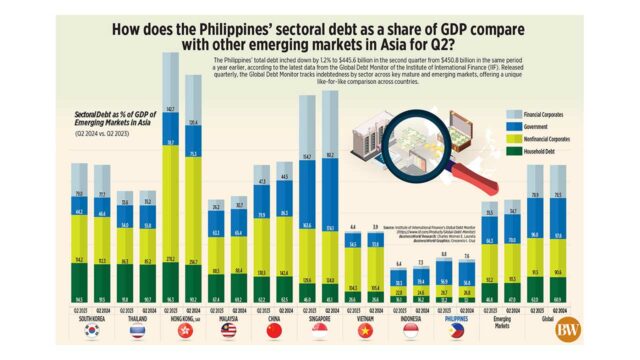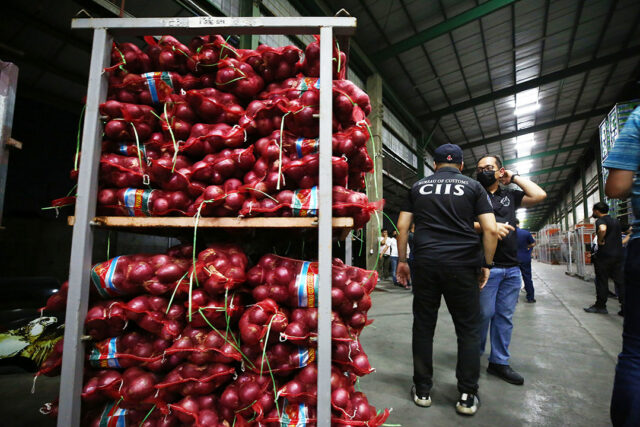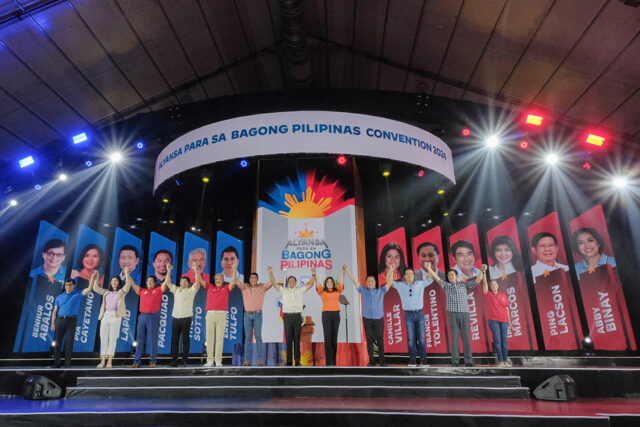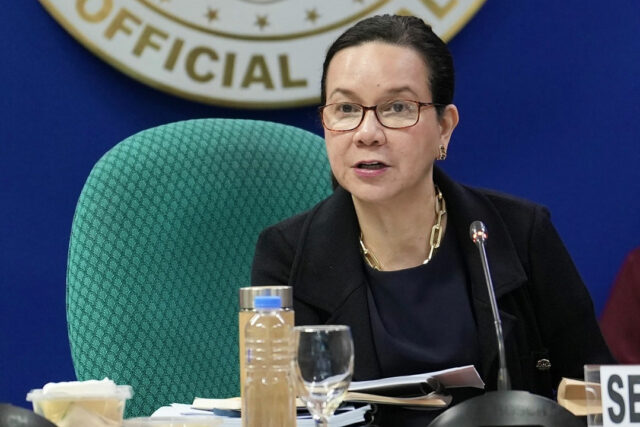By Kyle Aristophere T. Atienza, Reporter
PHILIPPINE President Ferdinand R. Marcos, Jr. on Thursday signed into law a measure classifying agricultural smuggling, hoarding, profiteering, and financing of these crimes as acts of economic sabotage.
But experts said the law could become useless in a country notorious for failing to apprehend big-time criminals, adding that having a local economy designed to meet local agriculture demands is the best deterrent to smuggling.
The law will go into the books as Republic Act No. 12022, the Anti-Agricultural Economic Sabotage Act.
Under the law, violators may face a fine that is five times the value of smuggled or hoarded agricultural products and face life imprisonment, the Agriculture department said in a statement.
The law treats smuggling and hoarding of agricultural food products as economic sabotage when the value of goods exceeds P10 million, it said.
“Creating cartels and financing smugglers and hoarders will also be considered economic sabotage.”
Agriculture stakeholders in August registered their opposition to the final version of the bill after a bicameral conference committee increased the threshold amount of agricultural smuggling as economic sabotage to P10 million from P3 million.
“Given such increase, the entry of seven containers of smuggled rice, four containers of smuggled vegetables and fruits, two containers full of smuggled chicken, or even one shipping container full of smuggled pork products will still not be qualified as economic sabotage,” they said in a letter addressed to Mr. Marcos.
“Despite the illegal entry of such a huge volume of agricultural products, it will be almost impossible to punish these smugglers with a graver penalty of lifetime imprisonment imposed by the bill,” they said.
“Thus, its deterrent effect against agricultural smuggling is greatly diminished.”
The presidential palace had yet to issue a copy of the signed law, but a government handout distributed at the signing ceremony said the law’s penalties aim to “safeguard the economy, preserve fair competition, and ensure the well-being of producers.”
It said the law “vests jurisdiction” over offenses with the Court of Tax Appeals.
Senate President Francis Joseph G. Escudero said in a statement that the law penalizes those who commit acts that aid in the commission of agricultural economic sabotage — such as the transport and storage of the smuggled goods — with a 20- to 30-year jail term and a fine twice the value of the agricultural and fishery products.
The law covers agricultural and fishery products such as rice, corn, beef and other ruminants, pork, poultry, onion, garlic, carrots and other vegetables, according to a government handout.
Products covered by the law also include palm oil, palm olein, raw and refined sugar, tobacco, fruits, salt, fish and other aquatic resources in their raw state or which have undergone the simple process of preparation or preservation for the market within the primary and post-harvest stages of the food supply chain.
NEW LAW’S ‘WEAKNESSES’
Former Agriculture Secretary Leonardo Q. Montemayor said while new law was a big improvement over the Anti-Agricultural Smuggling Act of 2016 in terms of its expanded coverage and enforcement structure, there were still weaknesses including the “exclusion of farmers and commodity producers” as permanent members of the Anti-Agricultural Economic Sabotage Council.
The council will be chaired by the President or a designated permanent representative.
Its members include the heads of the Department of Agriculture, Department of Justice, Department of Finance (DoF), Department of the Interior and Local Government, Department of Transportation, Department of Trade and Industry, the Anti-Money Laundering Council, and the Philippine Competition Commission.
A bicameral conference committee in August excluded seven representatives from the agricultural sector as regular members of the Council. Instead, they will be part of an advisory body that will only be called upon whenever needed.
Under the reconciled version of the bill, the DoF was included as a member of the Anti-Agricultural Economic Sabotage Enforcement Group, in a move that went against the call of agriculture stakeholders to prevent the Bureau of Customs (BoC) from having any participation in the enforcement team.
In their letter to the President in August, the stakeholders said the inclusion of the DoF “effectively defeats the intention to intensify the check and balance mechanisms in the BoC.”
They said the enforcement group should remain an independent body and be limited only to law enforcement agencies such as the National Bureau of Investigation, Philippine National Police, and the Philippine Coast Guard.
Mr. Escudero said in his statement that running after smugglers would also mean plugging leakages in the revenue stream of the government.
“The law will also result in improved collections by our revenue collecting agencies, which will translate to the delivery of more services to our people.”
Former Agriculture Secretary William D. Dar said there should not be political considerations in implementing the law.”
“The law is made more effective with much severe penalties including a whole of government approach with the President chairing the Council,” he said via Viber.
Federation of Free Farmers National Director Raul Q. Montemayor said the heightened penalties under the new law “will be useless if we cannot apprehend and prosecute supposed smugglers and hoarders.”
“This is what happened under the old law,” he said in a Viber message.
The Marcos administration has largely pinned the blame on rising prices of agriculture commodities on smuggling and hoarding.
Philippine inflation eased to 3.3% last month, slower than the 4.4% rate in July, due to a moderate rise in food prices and a decline in transport costs.
Rice inflation, which has been a major headache for the country in recent months, fell to 14.7% from 20.9% in July and 22.5% in June. Still, it remained the top contributor to August’s 3.3% inflation, which was within the government’s 2%-4% target.
Authorities last week flagged over 800 container vans carrying rice imports that were found sitting in a Manila port.
The 888 container vans carried 23,000 metric tons (MT) of imported rice or 0.75% of the total supply that has entered the country this year.
Agriculture Secretary Francisco P. Tiu Laurel, Jr. recently said the majority of the containers were still within the 30-day staying period allowed by ports, citing a Philippine Ports Authority’s statement on Monday that more than 300 containers were already claimed by their consignees.
INCREASED DOMESTIC PRODUCTION
“The issue of smuggling would be easily resolved if the local economy were to supply the needs of the population,” said Leonardo A. Lanzona, an economics professor at Ateneo de Manila University.
“Smuggling only becomes lucrative because we do not produce most of our agricultural products,” he said in a Facebook Messenger chat.
The Philippines is highly vulnerable to imported inflation as it imports much of its food. Agriculture imports in 2023 hit $17.92 billion.
To curb food inflation, Mr. Marcos earlier this year issued an executive order that cut the tariff on imported rice to 15%.
“The reduction of tariffs should have made smuggling less profitable. In all, if ever smuggling remains an issue, the only way to solve it is to increase domestic production,” Mr. Lanzona said.
“Government money is better spent on subsidizing farmers than setting up these councils.”
In my opinion, the success of this new law is greatly dependent on the governance and integrity of those tasked with its implementation,” University of Asia and the Pacific (UA&P) Center for Food and Agribusiness Executive Director Marie Annette Galvez-Dacul said in a Viber message.



 The second thing is the elegant, notebook design. The anodized Glacier White finish, alongside the compact dimensions of 357.7 by 262.5 by 17.6-19.8 mm, the laptop exudes a vibe that is more ‘professional’ than ‘gamer’. It feels solid, sleek, and, if not for the default RGB keyboard backlighting, it would not look out of place in even the most corporate of conference halls.
The second thing is the elegant, notebook design. The anodized Glacier White finish, alongside the compact dimensions of 357.7 by 262.5 by 17.6-19.8 mm, the laptop exudes a vibe that is more ‘professional’ than ‘gamer’. It feels solid, sleek, and, if not for the default RGB keyboard backlighting, it would not look out of place in even the most corporate of conference halls. Perhaps the laptop’s strongest asset, however, is its glorious 16-inch 3200×2000 IPS display, with a refresh rate of 165Hz supported by Dolby Vision and NVidia’s G-SYNC. The screen feels expansive, the colors are rich and vibrant, contrasts are crisp and smooth. There is very little more you can ask for. The display perfectly showcases the power of 8GB Nvidia GeForce RTX 4070 GPU, offering an impressive visual experience that can handle the latest games with ease.
Perhaps the laptop’s strongest asset, however, is its glorious 16-inch 3200×2000 IPS display, with a refresh rate of 165Hz supported by Dolby Vision and NVidia’s G-SYNC. The screen feels expansive, the colors are rich and vibrant, contrasts are crisp and smooth. There is very little more you can ask for. The display perfectly showcases the power of 8GB Nvidia GeForce RTX 4070 GPU, offering an impressive visual experience that can handle the latest games with ease. During testing, the Legion 7i effortlessly ran demanding titles like
During testing, the Legion 7i effortlessly ran demanding titles like  That said, the Legion 7i’s ColdFront Hyper thermal design does a great job managing the heat, as the inward-spinning fans eliminating the discomfort of constant hot air blowing onto your hand. Generally, the laptop maintains reasonable surface temperatures, although prolonged gaming sessions may lead to warm spots on the palm rest area, which could prompt some users to use an external keyboard or controller for added comfort.
That said, the Legion 7i’s ColdFront Hyper thermal design does a great job managing the heat, as the inward-spinning fans eliminating the discomfort of constant hot air blowing onto your hand. Generally, the laptop maintains reasonable surface temperatures, although prolonged gaming sessions may lead to warm spots on the palm rest area, which could prompt some users to use an external keyboard or controller for added comfort. The limited battery life makes switching between its different performance profiles on the Lenovo Vantage app an imperative. If you’re plugged in, turn on Performance mode to access the Legion’s unrestricted power. If you’re not, stick with the relatively weaker, but more battery-efficient Quiet mode. Fortunately, doing so is as easy as pressing the Fn+Q hotkey.
The limited battery life makes switching between its different performance profiles on the Lenovo Vantage app an imperative. If you’re plugged in, turn on Performance mode to access the Legion’s unrestricted power. If you’re not, stick with the relatively weaker, but more battery-efficient Quiet mode. Fortunately, doing so is as easy as pressing the Fn+Q hotkey. The Lenovo Legion 7i ambitiously aims to push the boundaries of gaming laptops to deliver power, performance, and portability in a single package. In many ways, it succeeds. With a stunning display, formidable specs, and a sleek design, it’s a strong choice for gamers, professionals, and content creators looking for a versatile machine that can transition seamlessly between work and play. However, this power comes at a cost — literally and figuratively.
The Lenovo Legion 7i ambitiously aims to push the boundaries of gaming laptops to deliver power, performance, and portability in a single package. In many ways, it succeeds. With a stunning display, formidable specs, and a sleek design, it’s a strong choice for gamers, professionals, and content creators looking for a versatile machine that can transition seamlessly between work and play. However, this power comes at a cost — literally and figuratively.



















